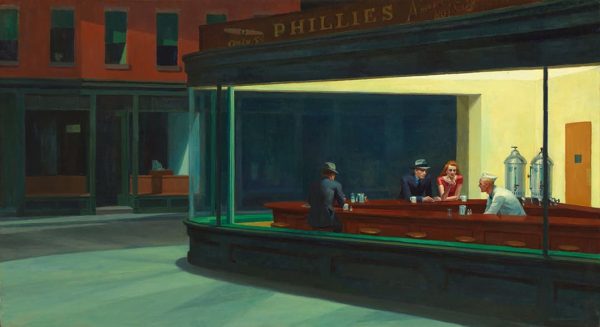Edward Hopper · Nighthawks
1942 – Óleo sobre lienzo – Art Institute of Chicago

Edward Hopper – Nighthawks – 1942 – Oil on canvas – Art Institute – Chicago

Edward Hopper – Nighthawks – detail 1

Edward Hopper – Nighthawks – detail 2

Edward Hopper – Nighthawks – detail 3

Edward Hopper – Nighthawks – detail 4

Edward Hopper – Nighthawks – detail 5
Imágenes: © Artists Right Society, New York
“Probablemente de forma inconsciente, estaba pintando la soledad de una gran ciudad”, dijo el propio Hopper de esta obra. Efectivamente, “Nighthawks” no es sólo la obra más famosa y reproducida del artista, sino que se ha convertido, por derecho propio, en el símbolo de la soledad de la metrópolis contemporánea y en uno de los iconos del Arte del siglo XX.
De esta pintura se han hecho multitud de interpretaciones y consideraciones subjetivas, demostrando así la terrible emoción que ésta provoca en el observador. La visión de estas cuatro figuras anónimas (misteriosamente, Hopper llamó a esta obra una pintura “de tres personajes”) en el interior de un sobreiluminado bar en la noche de una oscura jungla de asfalto consigue producir una sensación de soledad inevitable. A destacar que, al no representar la puerta de acceso al local, Hopper ha convertido el establecimiento en una prisión de vidrio en la que nadie puede entrar –ni salir.
Text: G. Fernández, theartwolf.com
Edward Hopper · Nighthawks
1942 – Oil on canvas – Art Institute of Chicago

Edward Hopper – Nighthawks – 1942 – Oil on canvas – Art Institute – Chicago

Edward Hopper – Nighthawks – detail 1

Edward Hopper – Nighthawks – detail 2

Edward Hopper – Nighthawks – detail 3

Edward Hopper – Nighthawks – detail 4

Edward Hopper – Nighthawks – detail 5
Images: © Artists Right Society, New York
“Unconsciously, probably, I was painting the loneliness of a large city”, Edward Hopper said about this work. “Nighthawks” is not only the most famous and reproduced work by the artist, but it has also become the symbol of the solitude in the contemporary metropolis, and it is now one of the undisputed icons of 20th-century art.
This famous painting is still open to many subjective interpretations. This nocturnal scene depicts four anonymous figures (mysteriously, Hopper called this painting “a three-character work”) inside a highly illuminated bar. There is nothing outside: just the darkness and loneliness of an asphalt and concrete jungle. By not showing the entrance to the bar, Hopper has turned it into a glass prison in which no one can enter (or leave).
Text: G. Fernández, theartwolf.com






